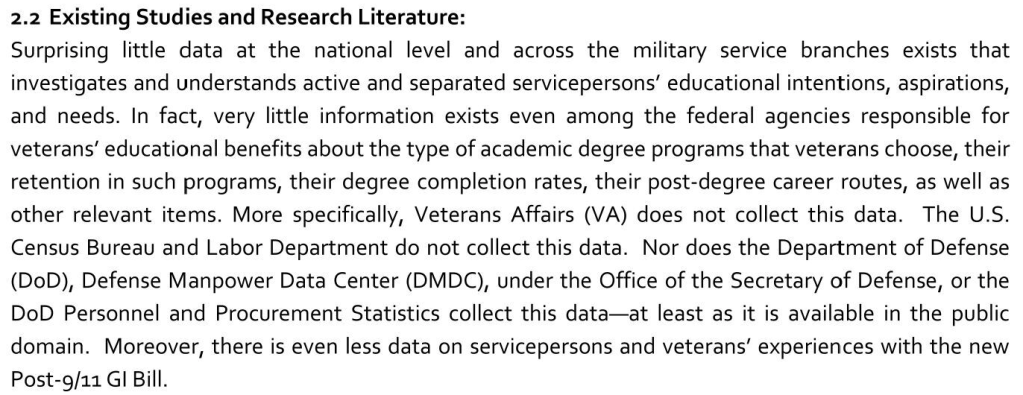A National Science Foundation-funded study was conducted in 2011 by Laura Steinberg, Corri Zoli, and Nick Armstrong of Syracuse University looking at veterans participation in engineering programs and challenges they face. I’m going to summarize their findings here and how it speaks to our goals at SVRN. The study can be found here: https://www.yumpu.com/en/document/view/31763028/finding-barriers-and-pathways-to-engineering-for-us-servicemembers
The Study
The study was aimed at addressing what the authors call “a scarcity of data on servicemembers’ educational aspirations and intentions, and thus, the critical importance of thinking about higher education from the point of view of servicemembers themselves” [p 1]. It was intended to examine this from the perspective of engineering and “… the often limited interest in pursuing degrees in engineering and STEM fields” [p 1]. The authors identify five initial assumptions in their survey:
- Veterans are a critical resource for US in private sector and government, posses “an abundance of technical training”, and “have the potential to form the backbone of US engineering and technology innovation” [p 1]
- Veterans are diverse and offer an “amazingly diverse pipeline for higher education” [p 1]
- The new GI Bill [Post-9/11] expanded veterans’ benefits and universities stand to gain from their increased presence on campuses
- Post-9/11 GI Bill education benefit has the potential to “enhance higher education infrastructure with new curricula, programs, courses, research, teaching, equipment, etc.” [p 2]
- This builds on the long history of collaboration between STEM fields and the government
The authors designed their study from the perspective of what universities can offer veterans (the traditional approach) and also what veterans can offer university campuses (which they claim is a unique approach). While the study is focused on engineering programs, the authors took an interdisciplinary approach to the study design, including experts in qualitative research design, educational theory, and graduate students from several disciplines.

Their methodology was a “mixed methods” approach, consisting of:
- Public record DOD reports
- An online survey with ~1200 respondents
- Focus group interviews of active-duty personnel conducted on 4 military bases resulting in 200+ unique data points
Some findings
In discussing findings, I’m going to focus on the ones that seem the most relevant to the goals of SVRN, namely research and advanced degrees, as opposed to those more relevant to private sector jobs.

The finding summarized in the article were derived from the active-duty focus group personnel, not the online respondents, and so didn’t reflect the attitudes and goals of veterans. However, I believe it can still inform us at SVRN as to what folks embarking on their educational journey post separation may or may not know about academia. Here I’ll summarize the findings that stood out to me as particularly relevant to SVRN:
- They found that operational specialty does not correlate well with technical educational aspiration or career goals. Servicemembers “reported that the often disliked their MOS; that what they were trained for did not turn out to be their job; and that they liked neither their job nor their MOS.” [p 11]. “There was generally a lack of consciousness about their technical expertise, capacity, and training… Many servicepersons were being streamlined or tracked into very traditional academic and job sectors i.e., law enforcement.” [p 11]. The authors infer from this that they need to approach educational aspirations “more broadly”.
2. The authors identified aspects of military culture that could be potential predictors of academic success, presented in this list from their article [p 13]:
